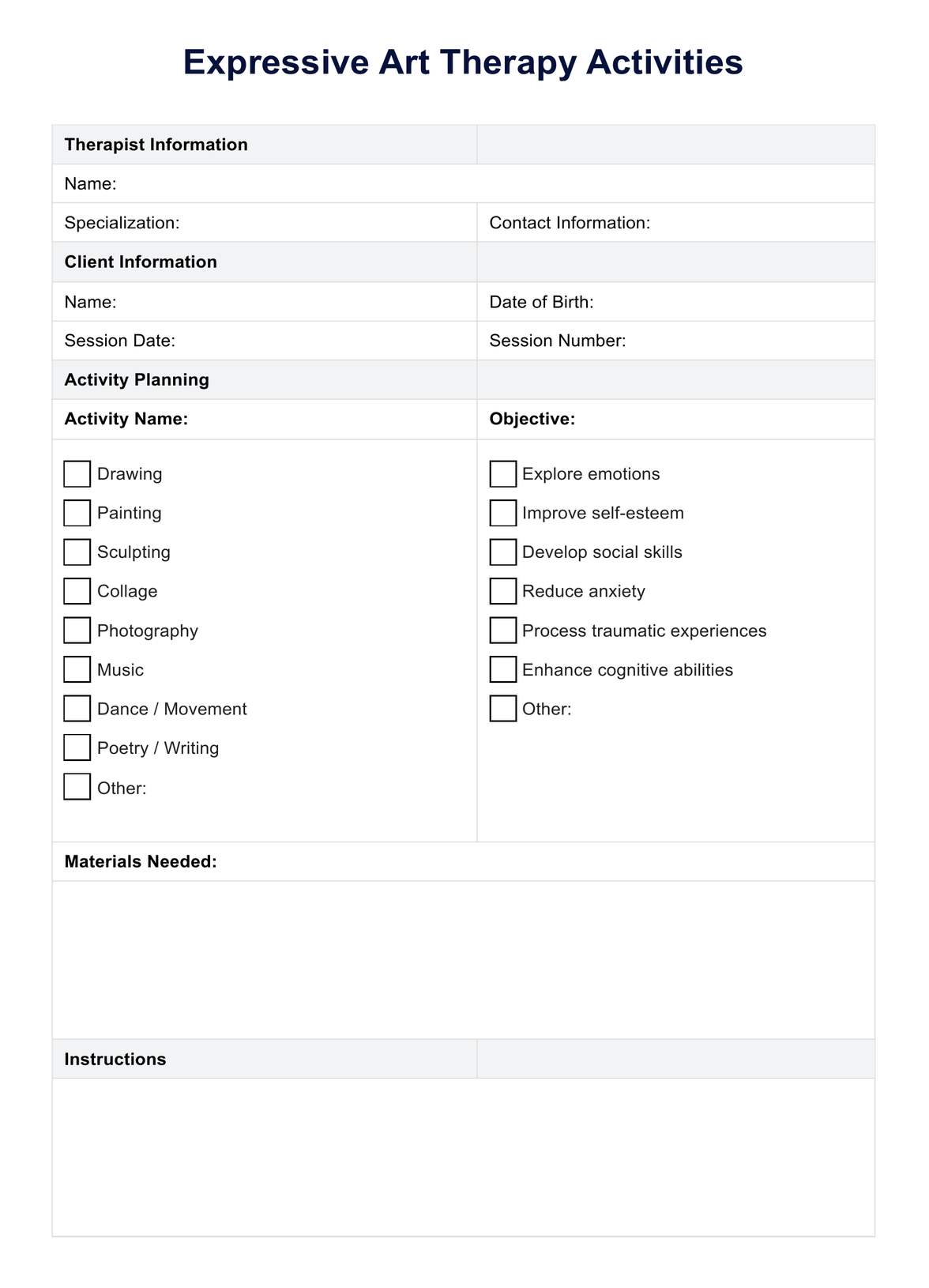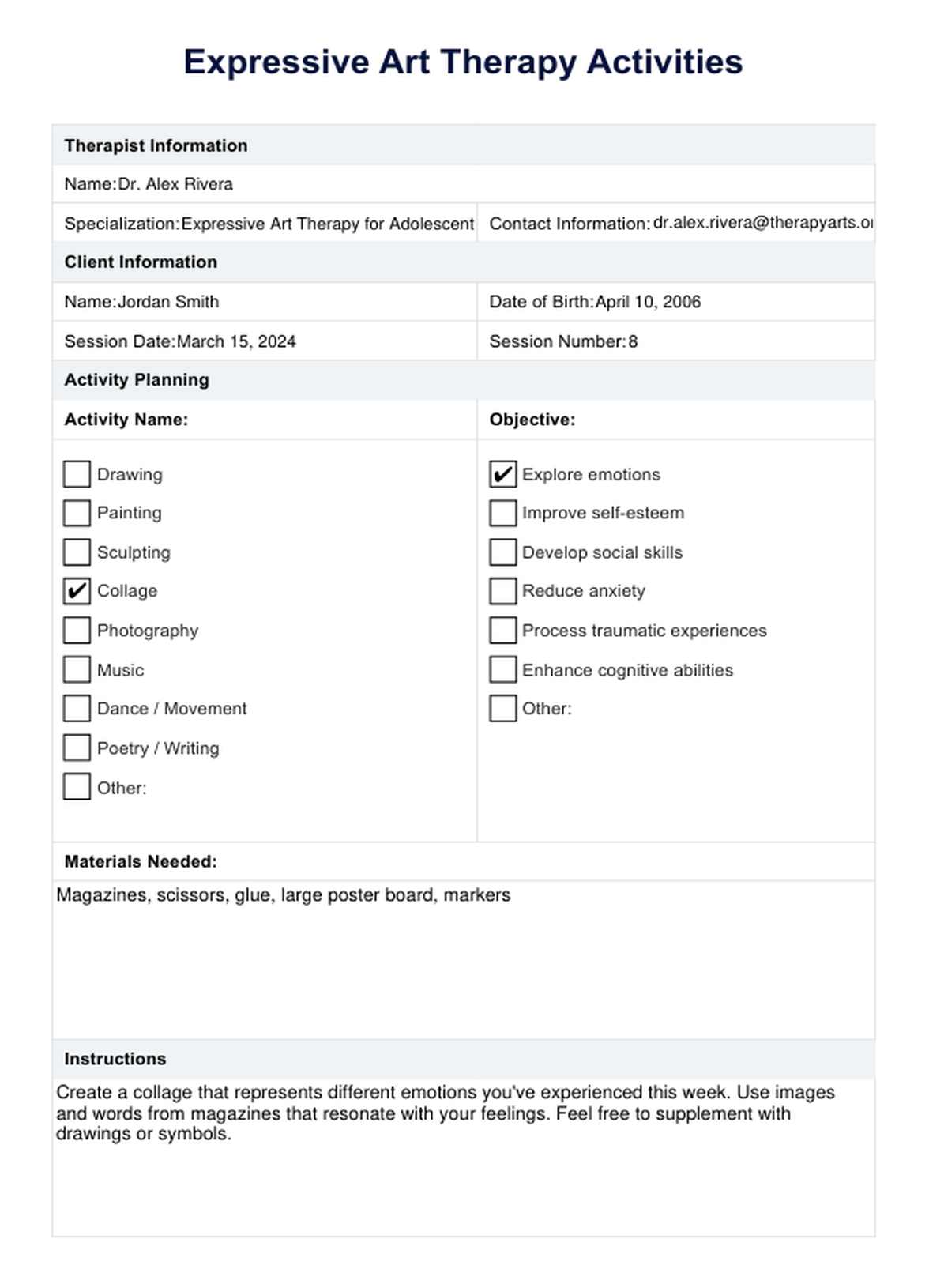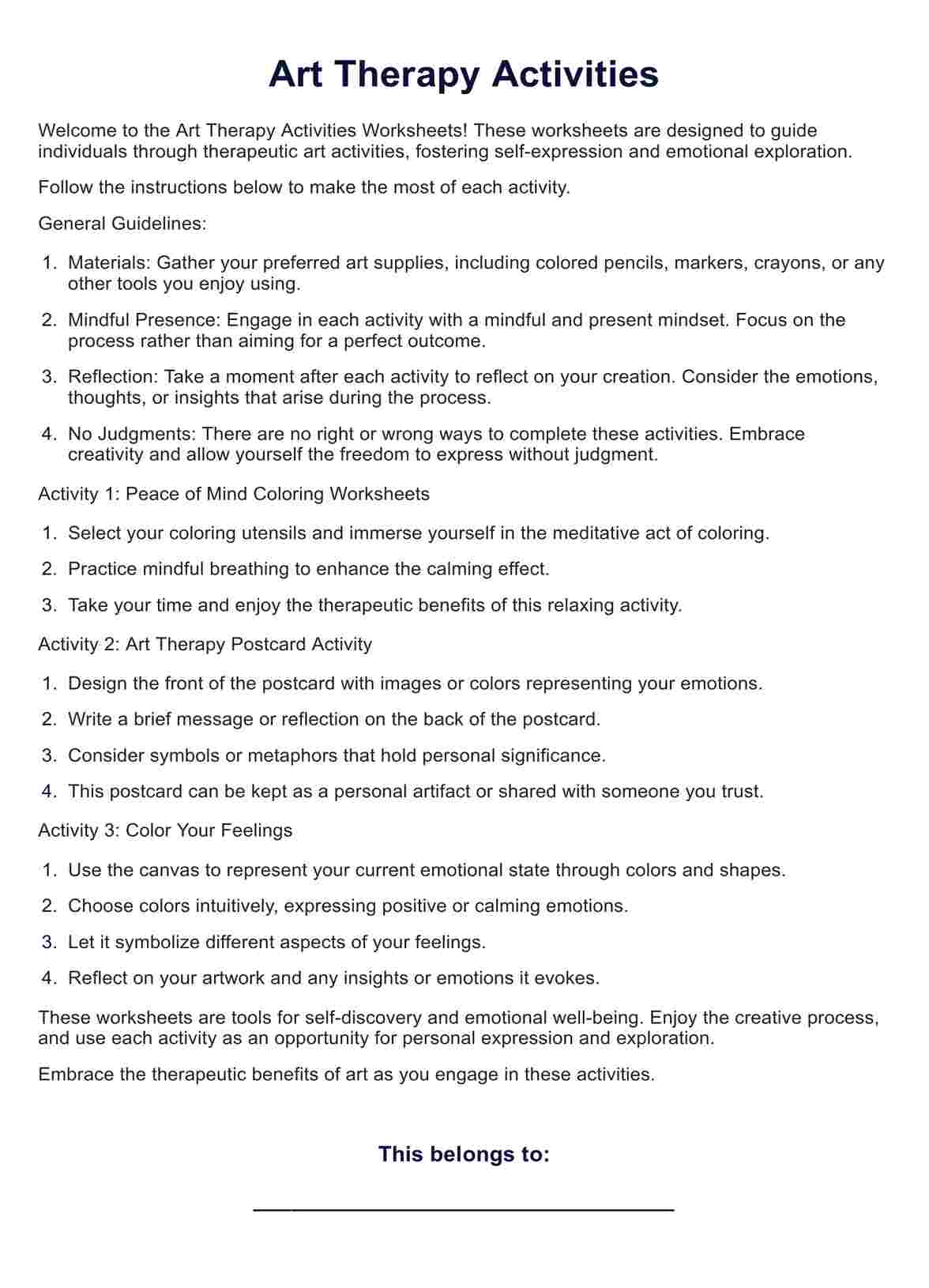Expressive Art Therapy Activities PDF
Explore the healing power of art with our Expressive Art Therapy guide and free PDF, aimed to enhance mental well-being through creativity.


What is art therapy?
Art therapy is a form of psychotherapy that uses the creative process of making art to improve and enhance the physical, mental, and emotional well-being of individuals of all ages. It involves using art exercises and materials provided to explore feelings, reconcile emotional conflicts, foster self-awareness, manage behavior, develop relationships and social skills, reduce anxiety, and increase self-esteem.
Under the guidance of a certified art therapist, participants engage in art-making as a means of non-verbal communication and expression, allowing for the exploration and resolution of issues that may be difficult to articulate with words or images alone. Art therapy can be practiced in various settings, including hospitals, clinics, schools, and private practices, and is tailored to meet the unique needs of each individual.
Expressive Art Therapy Activities PDF Template
Expressive Art Therapy Activities PDF Example
What is Expressive Art Therapy?
On the other hand, expressive art therapy is a therapeutic approach that uses the process of making art to improve a person's physical, mental, and emotional well-being. It encompasses various artistic disciplines, including finger painting, drawing, sculpture, music, dance, theater, writing, and other creative processes, as mediums for self-expression, inspiration, and communication.
This form of therapy is grounded in the belief that expression can foster healing and mental well-being in adults. It allows individuals to explore their feelings, reconcile emotional conflicts, foster self-awareness, manage behavior and addictions, develop social skills, relax, reduce anxiety, and increase self-esteem.
How to do Expressive Art Therapy?
Expressive art therapy can be practiced in various settings, including individual therapy sessions, workshops, or group classes, under the guidance of a qualified expressive arts therapist. Here's a general approach to engaging children in expressive art therapy:
- Choose your medium: Select an art form that resonates with you or feels like it might be a beneficial outlet for expression. This could be anything from painting, drawing, or sculpting to writing poetry, dancing, or playing music.
- Create a safe space: Ensure you have a comfortable and private space where you feel safe to express yourself freely through your chosen art form. The environment should feel welcoming and non-judgmental.
- Focus on the process, not the product: Emphasize the creative process and the feelings it evokes rather than the final product. Expressive art therapy is about exploration and expression, not creating a masterpiece.
- Express freely: Allow yourself to express whatever comes up, without censorship or judgment. This is a time to explore your thoughts, feelings, and experiences through your chosen medium.
- Reflect on your art: After the art exercises, reflect on what you've created and any thoughts or negative emotions that arose during the process. Consider what your art might be communicating about your inner state or experiences.
- Share and discuss (optional): If comfortable, share your art with your therapist or a supportive group. Discussing your art can provide deeper insights into your emotions and experiences and can be an important part of the therapeutic process.
- Regular practice: Like any form of therapy, it can enhance its benefits. Consistency helps deepen self-exploration and the therapeutic journey.
Why is this form useful for art therapists?
For several reasons, expressive art therapy is incredibly useful for art therapists, as it leverages the power of creative expression to facilitate healing, growth, and understanding in clients. Here's why this form is particularly beneficial:
- Broadens communication: It provides an alternative means of communication for patients who may find it difficult to express their thoughts and feelings verbally. Through art, participants can externalize complex emotions and experiences that might otherwise remain inaccessible or challenging to articulate.
- Enhances self-awareness: By engaging participants in the creative process, art therapists can help them explore their inner world, leading to greater self-awareness and insight. The act of creating art allows individuals to reflect on their emotional state, uncovering hidden feelings and unconscious thoughts.
- Facilitates emotional release: Art therapy offers a safe outlet for expressing and processing a wide range of emotions. Art can be cathartic, helping clients release pent-up emotions and relieve stress or anxiety.
- Supports healing and recovery: The therapeutic process involved in expressive art therapy can promote healing from trauma, grief, and other psychological issues. By symbolically working through their experiences in a creative manner, patients—especially children—can find pathways to healing and emotional restoration.
- Builds coping skills: Through the challenges and successes of the creative process, clients can develop resilience and coping strategies. Art therapists guide clients in exploring new perspectives and solutions through their art, which can be applied to real-life situations.
- Encourages personal growth: The process of engaging with art therapy can foster personal growth and development. Clients may discover new aspects of themselves, develop a stronger sense of identity, and enhance their self-esteem through creation and self-expression.
- Provides a holistic approach: Expressive art therapy integrates the emotional, cognitive, and physical aspects of individuals, offering a holistic approach to therapy. It can be particularly effective in addressing the needs of clients with complex issues by engaging the whole person in the therapeutic process.
- Adaptable to individual needs: This form of therapy is highly flexible and can be tailored to each client's specific needs, interests, and therapeutic goals. Art therapists can utilize various artistic mediums and techniques to best support each individual's journey.
For those interested in exploring expressive art therapy activities, consider checking out our Art Therapy Activities for Teens.
Examples of Expressive Art Therapy Activities
Expressive art therapy activities span a wide range of creative expressions, tailored to individual needs and preferences. These activities are designed to foster self-exploration, emotional release, and healing. Here are some examples:
- Collage-making: Using magazines, photos, and various materials, clients create a collage representing their feelings, dreams, or challenges. This activity helps in exploring and articulating complex emotions and thoughts.
- Clay work: Working with clay can be deeply therapeutic, allowing individuals to express themselves through shaping and molding. It's particularly useful for tactile stimulation and can help in expressing emotions that are hard to verbalize.
- Painting to music: Clients listen to music and paint what they feel, using colors and strokes that reflect the music's mood and emotional response. This activity bridges auditory and visual expression, enhancing emotional awareness and expression.
- Guided drawing: With prompts from the therapist, clients draw their responses to specific questions or themes, such as "Draw your safe place." This activity can uncover insights into personal experiences and feelings.
- Mask-making: Creating masks can help clients explore and express different aspects of their identity or emotions they might be hiding. This activity allows for a tangible exploration of self and the roles individuals play in their lives.
- Dance/movement therapy: Clients express themselves and explore emotions through movement. This can be particularly liberating for those who find verbal communication challenging.
- Writing and storytelling: Writing stories, poems, or journal entries allows clients to articulate thoughts and feelings through words, offering a path to understanding and healing.
- Photography: Taking photographs based on specific themes or emotional states can help clients observe the world through a different lens, offering new perspectives on their experiences.
- Sculpture: Building sculptures with various materials enables clients to give form to their internal experiences, offering a new way to communicate and explore personal narratives.
- Mandala-drawing: Creating mandalas offers a meditative and structured approach to art therapy. The repetitive nature of drawing circular patterns can be calming and centering, providing a space for introspection.
For those interested in exploring this more, consider downloading our Art Therapy Activities PDF.
Goals of Expressive Art Therapy
The goals of expressive art therapy are diverse and tailored to the individual's needs and personality, aiming to inspire and facilitate healing, growth, and self-discovery through creative expression. Here are some key objectives:
- Emotional expression and release: To provide a safe outlet for expressing complex emotions and experiences, enabling individuals to process and release feelings that may be difficult to articulate verbally.
- Self-exploration and awareness: To encourage self-reflection and deeper understanding of oneself through the creative process, leading to increased self-awareness and insight.
- Stress reduction and relaxation: To utilize the meditative aspects of creative expression to reduce stress and promote relaxation, contributing to overall mental and emotional well-being.
- Improving coping skills: To develop and strengthen coping mechanisms for dealing with life's challenges, using art as a tool for problem-solving and exploring alternative perspectives.
- Enhancing communication: To facilitate non-verbal communication and improve the ability to convey thoughts and feelings in a supportive environment, enhancing interpersonal skills.
- Fostering social skills: To create opportunities for social interaction and connection with others in group settings, building a sense of community and reducing feelings of isolation.
- Boosting self-esteem and confidence: To empower individuals by validating their creative expression and accomplishments, fostering a positive self-image and confidence.
- Promoting healing and recovery: To support the healing process from psychological trauma, illness, or injury by engaging the mind, body, and spirit in the creative process.
- Encouraging play and experimentation: To create a space for playfulness and experimentation, where individuals can explore new forms of expression and creativity without judgment.
Commonly asked questions
Art therapy typically focuses on a single art form as a therapeutic tool, such as painting or drawing, to facilitate personal growth and healing. Expressive arts therapy, however, integrates multiple forms of creative expression, including visual arts, music, dance, and writing, offering a more complete and holistic approach to art therapy techniques.
Engage in expressive art therapy by choosing a form of creative expression that resonates with you, such as drawing pictures, music, or dance. Use it to explore your feelings and experiences without judgment. Working under the guidance of a trained expressive arts therapist who can support and structure the process is beneficial.
Expressive art therapy for mental health uses various creative modalities to help individuals explore emotions, reduce stress, and improve symptoms of mental health conditions. It offers a safe, fun, and supportive environment to express thoughts, ideas, and feelings, facilitating personal insight and emotional healing.






















-template.jpg)






















































































